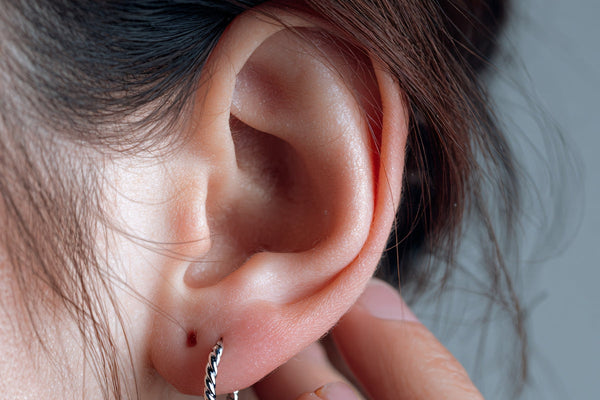
A cholesteatoma is a rare but serious ear condition that occurs when skin cells grow abnormally in the middle ear, behind the eardrum. While it isn’t cancerous, it can lead to hearing loss and other complications if left untreated.
At Leightons, we know ear health issues can feel worrying. The good news? Cholesteatoma can be managed effectively with the right care - starting with an accurate diagnosis. Regular hearing checks are essential for spotting early signs, and our expert audiologists are here to guide you every step of the way.
What is a cholesteatoma?
A cholesteatoma is an abnormal, non-cancerous, abnormal growth of skin cells and debris that forms a cyst-like pocket, usually behind the eardrum. Over time, this growth can put pressure on the delicate bones of the ear, causing damage if untreated.
There are two main types:
· Congenital cholesteatoma: present from birth and often detected during childhood.
· Acquired cholesteatoma: develops later, usually due to chronic ear infections or eardrum issues.
If untreated, cholesteatoma can erode bone, cause persistent infections, and affect balance and hearing. Early detection is key.
What causes cholesteatoma?
Occasionally, no clear cause is identified, but any condition that interferes with ear ventilation or healing after infection can increase risk. The middle ear is designed to stay clean and dry, but certain factors can interfere with this balance:
· Chronic ear infections: Repeated infections can cause the eardrum to retract, creating a pocket where skin cells can collect and grow.
· Eustachian tube dysfunction: The tube helps equalise air pressure between the middle ear and the outside environment. When it doesn’t work properly, pressure changes can pull the eardrum inward, encouraging a cholesteatoma to form.
· Perforated eardrum: A hole or tear in the eardrum can allow skin cells from the outer ear to move into the middle ear space.
Occasionally, no clear cause is identified, but any condition that interferes with ear ventilation or healing after infection can increase risk.
Recognise the symptoms of cholesteatoma
Cholesteatomas grow slowly, so symptoms may be subtle at first. Recognising the warning signs can help you seek treatment sooner and protect your hearing.
Typical symptoms include:
· Persistent or foul-smelling ear discharge that doesn’t clear up with standard treatments
· Hearing loss in one ear, often gradual
· A feeling of fullness or pressure in the affected ear
· Intermittent ear pain or discomfort
· Occasional dizziness or balance issues
· In some cases, a buzzing or ringing sound (tinnitus)
If left untreated, a cholesteatoma may lead to repeated infections, worsening hearing loss, or, in rare cases, facial muscle weakness. If you notice these symptoms, it’s important to have your ears checked by a professional.
How is cholesteatoma diagnosed?
An accurate diagnosis is the first step toward effective management. Because cholesteatomas can look similar to other ear conditions, professional examination is essential.
During your hearing appointment, your audiologist will:
· Use an otoscope to look inside the ear and check for signs of fluid, inflammation, or a growth behind the eardrum.
· Test your hearing to measure any hearing loss or changes.
If they detect potential warning signs through a professional ear health check and, if a cholesteatoma is suspected, we’ll explain your results clearly and refer you to an ENT specialist for medical care.
Treatment and management
Cholesteatoma does not resolve on its own - medical or surgical treatment might be required. The goal of treatment is to remove the cholesteatoma, stop infection, and protect your hearing. As the condition does not go away on its own, medical or surgical intervention is often required.
Treatment may include:
· Medication: Antibiotic ear drops or oral medication may help control infection or reduce inflammation before surgery.
· Surgery: The most common treatment, performed by an ENT specialist under general anaesthetic, involves removing the cholesteatoma and repairing damage to the eardrum or middle ear bones.
· Reconstruction: In some cases, reconstructive surgery (tympanoplasty) may be needed to restore hearing.
· Ongoing care: Regular check-ups are vital, as cholesteatomas can recur. Your hearing should be monitored to ensure it remains stable after surgery.
When to see a professional
You should seek advice if you experience:
· Persistent ear discharge that lasts longer than a week
· Gradual or unexplained hearing loss in one ear
· A sense of fullness, pressure, or popping in the ear
· Recurring ear infections or discomfort
If you’re unsure about your symptoms, booking an ear health check is a simple first step. Our audiologists can identify any signs of concern and guide you to the right care.
Book a free hearing test with Leightons
Our experienced audiologists can safely examine your ears, check for infection, wax build-up, or inflammation, and refer you for medical attention if needed.
We’re here to help you understand your symptoms, protect your hearing, and live life to the full.








